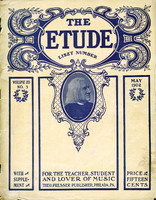An Interval Lesson. I.
Rule: When the upper of the two tones is in the Major Scale of the lower, the interval is Major or Perfect; Major if its number be 2, 3, 6, 7, or 9; Perfect if its number be 1, 4, 5, or 8.
First review the method of finding the number-name.
Rule: To find the number-name count the letters from the lower (as first) to the upper. Thus: From C to A is how many letters? Six. Then C to A is a sixth. It matters not, as to the number-name, how C or A may appear. Thus: C-sharp to A, C-flat to A, C-sharp to A-sharp, C-flat to A-flat, C to A-sharp, C to A-flat, etc., are sixths; the number-name of each is six. Whether they are major sixths or some other kind has to be determined by another rule.
Lesson.
Find the number-name of each of the following:
C to D, E-flat to G, F to B, D to E, A-flat to D- flat, F-sharp to C-sharp, C to B, B to C-sharp.
II.
Do you know the Scale of C-major? If you try to find what kind of interval is C to A, what do you
do? Simply ask if A (the upper tone) is in the Major Scale of C. Is it? Yes. Then C to A is a major sixth.
Try C to E. The number-name is what? C, D, E, 1, 2, 3, a third. Is E the upper tone in the Major Scale of C? It is. Then C to E is a Major third.
Lesson.
State the number-name of each of the following and tell which are Major and which are not Major:
F to G, C to E-flat, G to E, B-flat to D, C to B, G to F, F to B-flat.



